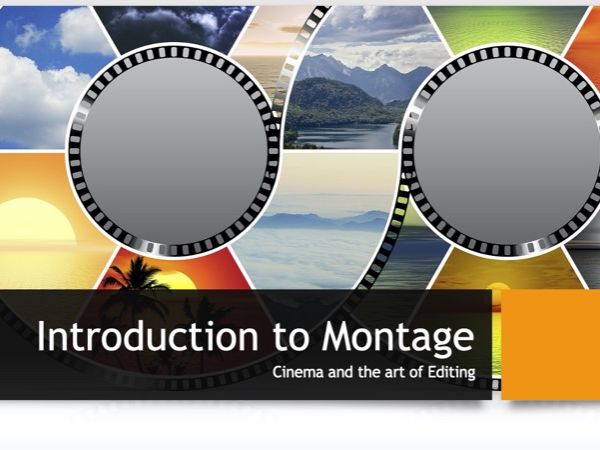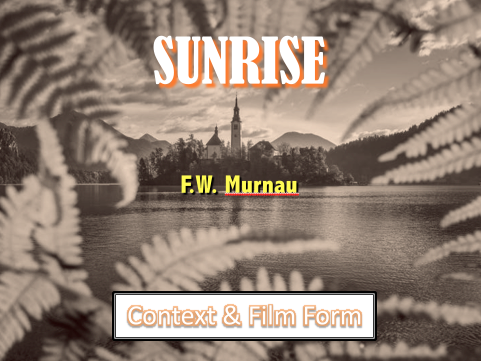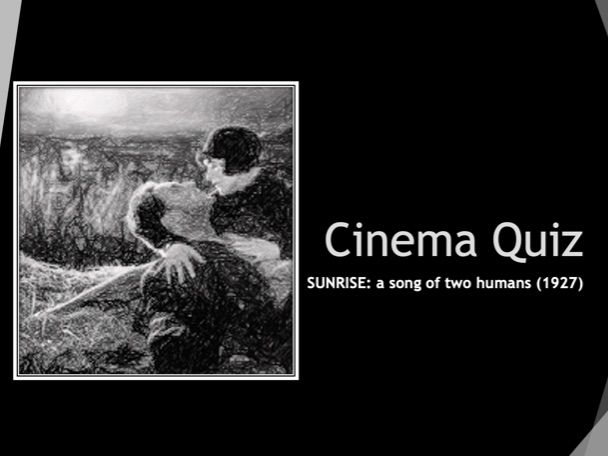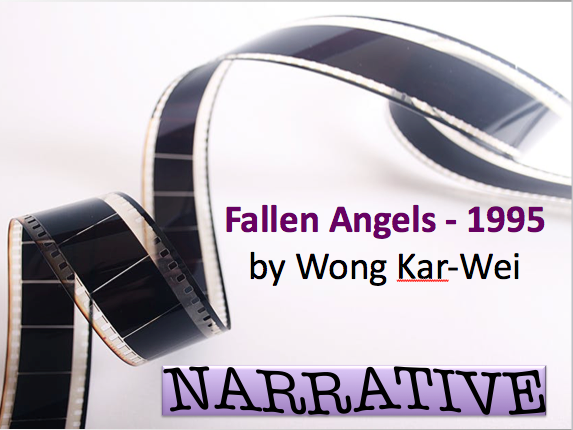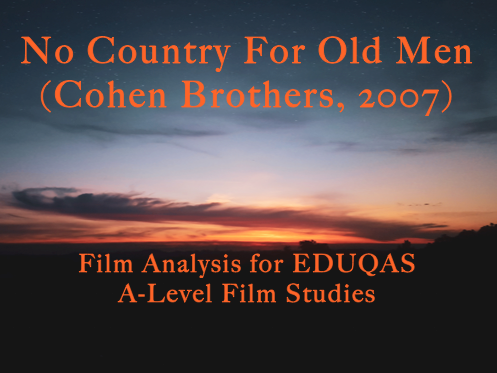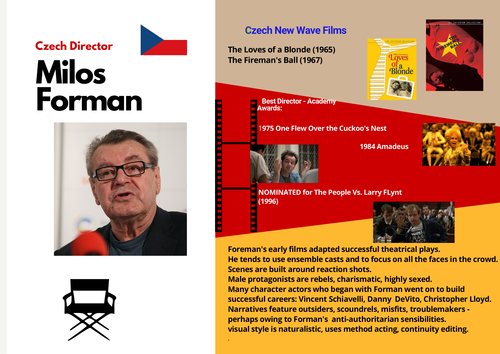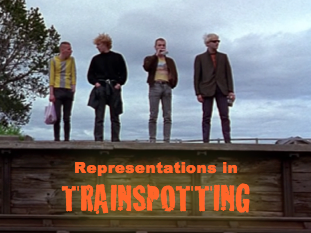59Uploads
13k+Views
2k+Downloads
All resources

Cinema and the Art of EDITING
For both film and media studies, this 14-slide full colour, interactive PowerPoint presentation provides a brief introduction to the basics of film editing (montage).
The six elements of an edit are introduced, as well as a discussion of pace, style of editing and parallel editing (cross cutting).
Helpful links to YouTube videos provide illustrative examples of the terminology presented.
The Presentation - along with Q&A and examples - should fill a 1 hour lesson.

EDUQAS FILM STUDIES A-Level - Silent Cinema Sunrise (F.W. Murnau)
This 39-slide fully interactive presentation ends with exam questions and guidance from the EDUQAS boards, as well as offering historical context and aesthetic characteristics of German Expressionist cinema, with special focus on SUNRISE (FW Murnau).
This presentation is excellent for exam revision and conveys the key talking points for this section of the **Film Studies **Component 2 paper.

A-Level Film Studies: Sunrise (Murnau, 1927) Close Study
This GERMAN EXPRESSIONIST film from the late silent period showcases many features of German Expessionist cinema, as well as being a key example of a film made in Hollywood for an American audience. Made in 1927 by Fox Studio, this film forms the basis of a lesson around German Expressionist cinema and its visual techniques. This 32-Slide presentation provides lots of detail as well as explanation about how certain visual effects were achieved.
Ideal for teachers fdollowing the EDUQAS Film Studies A-Level, Component 2.

Film Studies A-Level Revision Quiz (Sunrise, 1927)
This is a great revision exercise for the EDUQAS Film Studies A-Level, Component 2, Global Filmmaking Perspectives: Silent Cinema.
This is a 20 slide Quiz presented in PowerPoint.
It works well for team or small group competitions.

'Captain Fantastic' Scene Analysis
For Eduqas A Level Film Studies, this 43-slide full colour interactive presentation prepares students to analyse how cinematography and mise-en-scene are used to convey key narrative meanings. Students are encouraged to question, discuss and share their own thoughts and there is a strong emphasis on uses of cinematic terminology as well as analysis and exam preparation (with a practice exam question).

EDUQAS A Level Film Studies - Gender in Some Like It Hot
This 25 Slide PowerPoint Presentation can be used for an hour long lesson on gender representations in Billy Wilder’s 1959 film ‘Some Like It Hot’. This can be used for the Component 1A. American Film Exam preparation in Film Studies, or it could be useful in AS Film Studies or Media Studies to discuss gender transgression, homoerotic subtext and feminist themes or messages in the film.
The film challenges gender binaries and stereotypes and cleverly uses subtext and indirect or double meanings to get across its progressive messages in subtle ways that would not have alienated 1950’s American audiences.
This is an interactive presentation that ends with a 15 minute exercise.

Analysing Class representations in TRAINSPOTTING and FISH TANK (Arnold, 2009)
For **FILM STUDIES A-LEVEL **
This class exercise allows students to consider class representations in the 2009 UK independent film Fish Tank.
It will prompt discussion and allow students to think about how a variety of characters are represented.
The objective is for students to fill in their worksheets independently or in pairs, and then for each individual or pair to feedback to the whole group. In this way, a wide range of answers and insights can be explored.
The exercise could fill nearly an entire 1 hour lesson, depending upon the group size.
Bundle Sale

Religious Studies Bundle
This bundle contains three colorful, interactive PowerPoint Presentations that can be used for full lessons on religious beliefs about a variety of topics, including: human rights, social justice, law, secularism, crime and punishment.
It references both Christianity and Islam and can be used to broaden discussion to more philosophical questions such as:
What is the relationship bewteen religious concepts of justice and society’s laws?
Which is the best reason / purpose for punishment?
Why do liberals believe that morality is a private matter?
Sale

Religious Versus Secular Laws
This 38 full color **interactive **slide presentation can be used to teach many concepts pertaining to religion and society. It explains the relationship between modern states (primarily the United States and Great Britain) and religions (with focus on Christianity & Islam). Concepts such as secularism, liberalism, theocracy and apostasy are included. Religious teachings are used and analysed, so that students are taught to demonstrate knowledge of **religious approaches to law **as well as applications and analysis. Exam practice questions are provided as well as guidance on how to answer them.
This is also useful for citizenship and cultural studies courses.
Sale

Religious Attitudes to Sex: Christianity & Islam
This full colour 13-slide PowerPoint presentation covers the principle beliefs about sex and its proper context in both the Christian and Islamic faiths.
It provides a good overview for this topic for the GCSE in Religious Studies and works well as a lesson plan if coupled with a revision quiz or practice test question. THe resource ends with two questions that could be used as discussion prompts or retention checks.

Fallen Angels (Wong Kar-Wei) - a narrative study
This fully animated, interactive 20 Slide illustrated Power-Point presentation forms the basis of a lesson, ideal for a post-screening discussion of narrative in Wong Kar-Wei’s 1995 Hong Kong New Wave film FALLEN ANGELS. The presentation provides several opportunities to pause and discuss aspects of narrative in the
film and encourages students to think about the ways in which Wong’s cinema breaks away from conventional genre storytelling methods.
The presentation is ideal for the Global CInema / Experimental Cinema component of EDUQAS Film Studies A-Level or for any film studies course interested in Hong Kong New Wave, Auteur studies, or Global Cinema.

Movie-Themed Treasure Hunt
This is an activity for team or pairs from Years 11+ and involves an active search for the answers, which are interdependent, so that one answer leads to another as students progress.
The game could be set up as a race to the finish line. Depending upon the research abilities and cinematic specialist knowledge of the team, the game could take anywhere from 15 minutes to 45 minutes to complete.
Included in this resource pack is: a treasure hunt ‘map’, two styles of answer sheets for students/teams, and an answer key for teachers.

No Country For Old Men Analysis (A-Level Film & Media Studies)
This fully animated, interactive presentation is comprised of 43 full colour slides. The analysis of narrative, formal elements and spectatorship aims at preparing film studies students for the A-Level Exam, (EDUQAS FIlm Studies, Component 1B - American Cinema).
It is equally useful for any film or media course. Elements of narrative, as well as camera, sound design, mise-en-scene and lighting are all analysed in this comprehensive study of this modern Western gothic film.
This presentation is designed to form the basis for a full one hour lesson, and could be extended to further sessions.
Bundle

EDUQAS FILM Spectatorship Bundle
This collection of resources provides a range of
classroom ready resrouces to tackle the FIlm Studies A Level Component 1B. - Spectatorship Topic.
The Films referenced and used as examples include No Country for Old Men, Carol and Winter’s Bone. There is also an introductory PowerPoint with an overview of what examiners mean by ‘Spectatorship’ and clear guidance on how to apply it to specific films.
There is a Test included as well.

TIMBUKTU - a film by Abderrahmane Sissako (2014)
This 40-slide full colour Power Point Presentation allows for a diverse range of topics to be studied. It covers history, culture, religious themes and filmmaking/media studies.
The film is about the destruction of culture and heritage, as well as occupation/colonialism, religious freedom, and human rights. The presentation also focuses on the film and its production, including representations and issues addressed by the filmmaker.
The film was produced to include the languages of the region in which it is set, including French, Tamasheq, English and other African dialects.
This resource facilitates rich discussion on topics such as: historical events, religious law, the value of cultural preservation and women’s rights.
It is appropriate for students aged 16 - 18. The violence of some events could be triggering for younger years.

Milos Forman Auteur Director Poster
This full colour poster outlines Czech-American film director Milos Forman’s key directorial attributes and achievements.
Perfect for the Auteur study question on the Eduqas Film Studies A-Level curriculum.

Eduqas A-Level Film: Taxi Tehran (Contextual Study)
This full color, animated, interactive PowerPoint Presentation includes 49 slides with detailed discussion of context for the 2015 film. The context closely follows the Lisa Wardle Textbook to prepare A Level film studies students for the Component 2A. examination question. There are practice questions, exercises, and discussion prompts to get students involved in an interactive lesson. The resource should cover a full two hour lesson.
In addition this resource can be used for a contemporary cultural study of life in Iran. Panahi is an internationally celebrated director whose work (including Taxi Tehran) has won critical acclaim and major awards. This film offers a “way in” to Iran including its theocratic regime, its history and its artistic culture.
Themes explored: Women in Iran, Ethnicity, Representations of generational differences, history, crime & punishment, political dissent and its consequences and the nature of filmmaking itself.

SUNRISE (FW Murnau, 1927) -- Test
Basic Comprehension questions - Test - for SUNRISE, Eduqas A-Level Film Studies.

What is THE BECHDEL TEST?
A brief explanation of the Bechdel Test and what it measures. The test is widely regarded as a measure of female representation in film, and provides a useful ‘rule’ by which representation of women / girls can be measured.

REPRESENTATIONS IN *TRAINSPOTTING*
This is a set of notes to help for revision of TRAINSPOTTING for film studies A-Level candidates.
Representations analyzed include:
Nationality
Class
Gender
Age

